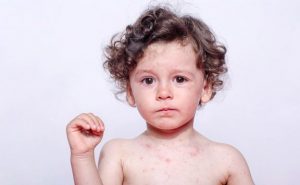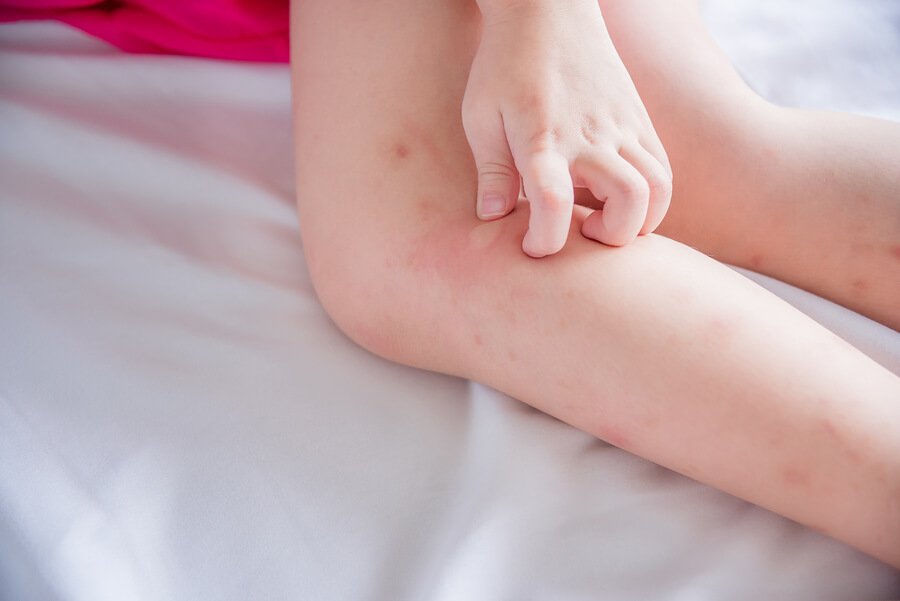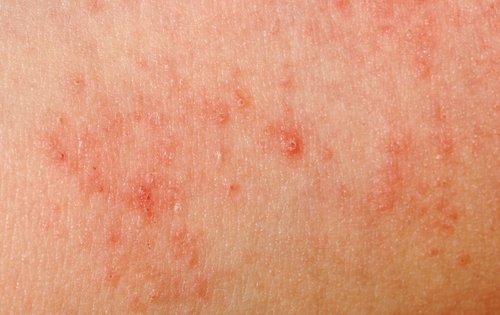Allergies to Sweat in Children: Symptoms and Treatment

Sweating is the body’s response to an increase in temperature. The sweat that evaporates from the skin cools the body. However, sometimes kids can develop allergies to sweat.
The common causes of sweating, which can worsen these symptoms, include sports, high temperatures and emotional stress.
Consequently, sweat can cause a skin reaction, creating blemishes and red spots. If this happens to your child, it’s important that you go to the pediatrician. He or she will analyze the cause and tell you what medication you need.
Babies and children have sensitive skin, and the increase in body temperature is what causes this allergy. While it’s true they can get rashes anywhere, they’re most common on their stomach and extremities.
The appearance of spots usually causes itching and discomfort in children. They may also experience headaches or heart palpitations.
Types of allergies to sweat in children
Problems such as dermatitis, urticaria or dyshidrosis are associated with allergies to sweat in children. These are the three most common ones:
1. Atopic dermatitis
Atopic dermatitis is characterized by redness on the face. It appears on the forehead and cheeks. Additionally, it shows up on the head, wrists, elbows, knees, ankles and neck.
In general, atopic dermatitis can occur from contact with irritants such as soap and detergent. It can also occur because of heat and sweat.
We recommend you gently rinse and dry the child’s skin. This will prevent sweat or other irritating products for coming in contact with the skin.

2. Urticaria
The second type of sweat allergy appears on the skin with red spots and, sometimes, itching. Inflammation mainly affects arms, legs and chest. However, it can appear anywhere on children’s bodies.
Urticaria can go away on its own in a few hours or days. However, this condition is very annoying. Therefore, consult your child’s doctor so he can prescribe a medication to reduce swelling and itching.
3. Dyshidrosis
Sweating and humidity are factors that cause this disorder. It can sometimes be painful for babies. This type of allergy is known as a skin disorder close to eczema. It usually affects their hands and feet.
This acute or chronic skin condition forms bullous lesions. The treatment is usually local. Apply an antiseptic and anti-inflammatory ointment to relieve pain.
“While it’s true they can get rashes anywhere, they’re most common on their stomach and extremities.”
How to prevent allergies to sweat in children
In most cases, kids’ reaction to sweat disappears in a few days. To help relieve symptoms, keep in mind that moisturizers are ideal. They relieve the itching sensation and get rid of rashes.
As always, prevention is the best medicine. So here’s a list with some simple tips to treat allergies to sweat in children. Take notes!
- Beware of chemical products. Symptoms often get worse by using chemicals.
- When your child goes to shower, he should use warm or cold water. This reduces the change of a breakout.
- Opt for cotton clothes instead of synthetic fabrics. They help your child sweat better.
- Choose breathable clothing when playing sports. They’ll prevent excess sweating.
- Avoid using sponges so you don’t accidentally hurt your child.

- Cut your child’s nails to avoid causing injuries to the affected areas.
- Anti-inflammatory creams can be a perfect solution to bring down swelling.
- Don’t overly protect your child. Also, be careful with the temperature changes from going to one place to another.
- Keep your child’s skin clean and hydrated.
Consult your doctor
In addition, you should know that this allergy is common. It’s due to the reaction of sensitive skin to sweating.
Don’t worry too much, as it usually improves by taking proper precautions. Also, as your child gets older, these kinds of problems disappear altogether.
Finally, as a mother, the important thing is to know how to act. Going to the dermatologist is key. He can identify the cause and let you know what medication to use.
Sweating is the body’s response to an increase in temperature. The sweat that evaporates from the skin cools the body. However, sometimes kids can develop allergies to sweat.
The common causes of sweating, which can worsen these symptoms, include sports, high temperatures and emotional stress.
Consequently, sweat can cause a skin reaction, creating blemishes and red spots. If this happens to your child, it’s important that you go to the pediatrician. He or she will analyze the cause and tell you what medication you need.
Babies and children have sensitive skin, and the increase in body temperature is what causes this allergy. While it’s true they can get rashes anywhere, they’re most common on their stomach and extremities.
The appearance of spots usually causes itching and discomfort in children. They may also experience headaches or heart palpitations.
Types of allergies to sweat in children
Problems such as dermatitis, urticaria or dyshidrosis are associated with allergies to sweat in children. These are the three most common ones:
1. Atopic dermatitis
Atopic dermatitis is characterized by redness on the face. It appears on the forehead and cheeks. Additionally, it shows up on the head, wrists, elbows, knees, ankles and neck.
In general, atopic dermatitis can occur from contact with irritants such as soap and detergent. It can also occur because of heat and sweat.
We recommend you gently rinse and dry the child’s skin. This will prevent sweat or other irritating products for coming in contact with the skin.

2. Urticaria
The second type of sweat allergy appears on the skin with red spots and, sometimes, itching. Inflammation mainly affects arms, legs and chest. However, it can appear anywhere on children’s bodies.
Urticaria can go away on its own in a few hours or days. However, this condition is very annoying. Therefore, consult your child’s doctor so he can prescribe a medication to reduce swelling and itching.
3. Dyshidrosis
Sweating and humidity are factors that cause this disorder. It can sometimes be painful for babies. This type of allergy is known as a skin disorder close to eczema. It usually affects their hands and feet.
This acute or chronic skin condition forms bullous lesions. The treatment is usually local. Apply an antiseptic and anti-inflammatory ointment to relieve pain.
“While it’s true they can get rashes anywhere, they’re most common on their stomach and extremities.”
How to prevent allergies to sweat in children
In most cases, kids’ reaction to sweat disappears in a few days. To help relieve symptoms, keep in mind that moisturizers are ideal. They relieve the itching sensation and get rid of rashes.
As always, prevention is the best medicine. So here’s a list with some simple tips to treat allergies to sweat in children. Take notes!
- Beware of chemical products. Symptoms often get worse by using chemicals.
- When your child goes to shower, he should use warm or cold water. This reduces the change of a breakout.
- Opt for cotton clothes instead of synthetic fabrics. They help your child sweat better.
- Choose breathable clothing when playing sports. They’ll prevent excess sweating.
- Avoid using sponges so you don’t accidentally hurt your child.

- Cut your child’s nails to avoid causing injuries to the affected areas.
- Anti-inflammatory creams can be a perfect solution to bring down swelling.
- Don’t overly protect your child. Also, be careful with the temperature changes from going to one place to another.
- Keep your child’s skin clean and hydrated.
Consult your doctor
In addition, you should know that this allergy is common. It’s due to the reaction of sensitive skin to sweating.
Don’t worry too much, as it usually improves by taking proper precautions. Also, as your child gets older, these kinds of problems disappear altogether.
Finally, as a mother, the important thing is to know how to act. Going to the dermatologist is key. He can identify the cause and let you know what medication to use.
All cited sources were thoroughly reviewed by our team to ensure their quality, reliability, currency, and validity. The bibliography of this article was considered reliable and of academic or scientific accuracy.
- Álvaro Lozano M. Urticaria y angioedema. Protoc diagn ter pediatr. 2019;2:149-60.
- Boguniewicz, M., Covar, R. A., & Fleischer, D. M. (2010). Trastornos alérgicos. In W. W. Hay, M. J. Levin, J. M. Sondheimer, & R. R. Deterding (Eds.), Diagnóstico y tratamiento pediátricos, 19e. McGraw-Hill Education. https://doi.org/10.1016/j.biocon.2004.03.011.
- Escarrer Jaume M, Guerra Pérez MT. Dermatitis atópica. Protoc diagn ter pediatr. 2019;2:161-75.
- Young, S. H. (2005). Alergias. Ediciones Granica SA.
This text is provided for informational purposes only and does not replace consultation with a professional. If in doubt, consult your specialist.








